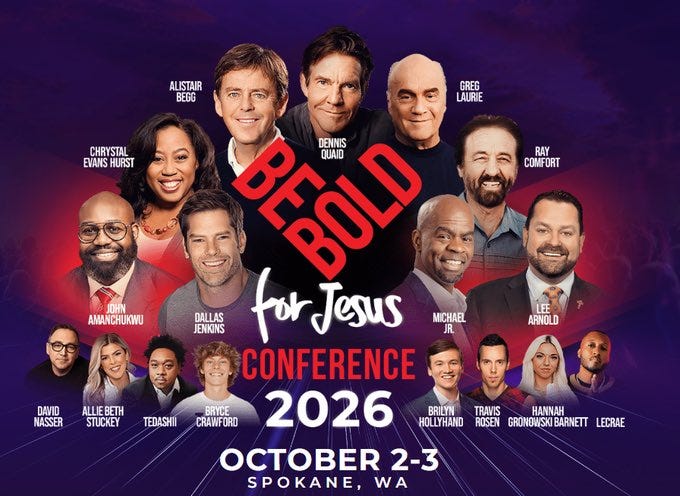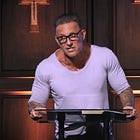The Great Evangelical Schism: Prologue
A marquee for an evangelical conference I had never heard of came into my purview yesterday. Rather than immediately try to break it down to its individual, mind-boggling elements, I’ll first place it below this paragraph and allow you to ponder its mysteries and, as I did, spend a few minutes in a state of wondering confusion.
If you aren’t an evangelical Protestant, familiar with its micro-celebrity culture, you probably know who Dennis Quaid is—I would have preferred Randy—but you likely have no clue who the rest of these people are, nor why they’re important enough to have their headshot emanating from the neon glow of a vessel that appears to be travelling at the speed of light. Rest assured, no evangelical Protestant, regardless of what sub-culture he comes from, can tell you who more than half a dozen people in this marquee are, and we are just as confused. Googling names doesn’t make it any better. Why are a respected Reformed Baptist preacher (until his allies attempted to cancel him) and a founding member of the Calvary Chapel movement doing a “Christian” conference alongside a professional ninja/public speaker and the star of the movie Selfie Dad? Why is the daughter of celebrity pastor Tony Evans billed above the creator of The Chosen, himself born into the business? Why is a nineteen year-old political activist who travels in a private jet for his Turning Point USA events booked closer to the center than a much-better-known, culture-warring podcaster, who charged $5,000 for a “Premium All Access Package” at her own conference that is most associated with the evangelical media tribe that tried to cancel the Reformed Baptist and TV show producer? Why is this happening in Spokane, Washington, of all places? To get lost in these weeds, as fascinating as they are, is to miss the larger takeaway.
This is a conference for the religion of Evangelicalism, not the religion of Protestant Christianity. We are in the middle of a great schism that I believe will end with two competing modes of Christianity that are as different to each other as Eastern Orthodoxy is from Roman Catholicism, or even as different as Lutheranism is from Roman Catholicism.
This is not just vibes from a poster, there are hard metrics behind this schism. Only 16% of American Christians have an orthodox understanding of the Trinity. Nearly one third of self-described evangelicals deny the divinity of Christ, though 98% of them will tell you that marriage is between one man and one woman. The “Be Bold for Jesus” conference is a touch-point into this mode of religion, where, among other factors, theology and doctrine take a quantifiable back seat to culture.
Take the metric on orthodox Trinitarianism; what would we see if it was stratified into different modes of Protestantism? Could we not expect confessional, denominational Christians, who catechize their children and sit under a pastor who is licensed by a presbytery or synod, to score better than someone who goes to a church with a verb like “thrive” or “believe” for a name and a pastor/CEO with no training, but who “felt the call to ministry”? This is not a hypothetical. People are being taught absolutely broken, Nicene-Creed-violating theology in American megachurches with exponentially more members than most conservative Presbyterian or Lutheran churches. Books that create utter Trinitarian confusion are being marketed for church studies by major Christian publishers.1
What do these two types of Christians really have in common, beyond a shared verbal assent to the Five Solas? What are the clear lines of schism and where does it get muddy? These are the questions I will attempt to answer over the course of this series of essays.
“In Genesis 1:26 God says, ‘Let us make man in our image.’ God announces his intention to the group. Who are you talking about? To his heavenly host— his counsel. He is not speaking to the other members of the Trinity, because God cannot know anything that they do not know!”
Michael Heiser, Supernatural (Lexham Press, 2015), 28
“For always present with him are the Word and Wisdom, the Son and Spirit, by whom and in whom he made all things freely and of his own will, to whom he also speaks, when he says, “Let us make man after our image and likeness” (Gen 1:26)”
Irenæus, Against Heresies (~180 AD)





Another interesting development is the eclectic, “post-protestant” movement signified by Comer. I’m trying to figure out where it fits in to this schismatic moment.
This article was interesting, thank you. I've commented on these phenomena here and pointed people to this article: https://mothwo.blogspot.com/2025/10/well-thats-weird.html .